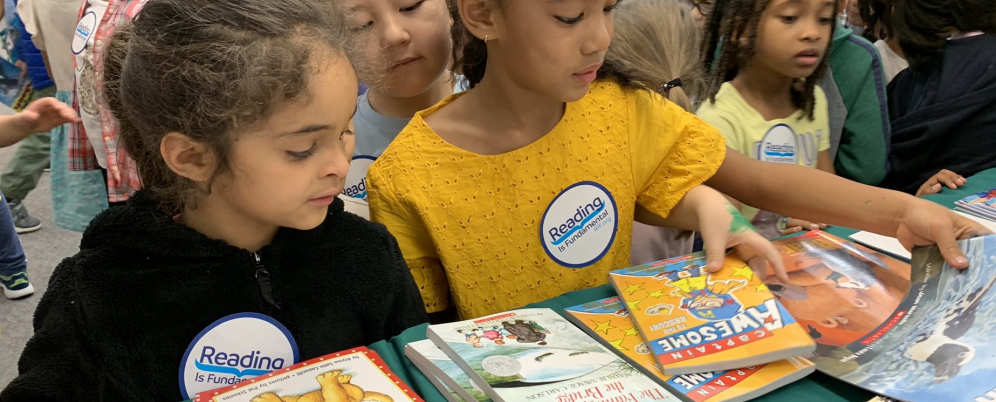Reading Rescue: Boosting Comprehension with Evidence-Based Strategies
Recent NAEP scores reveal the true scope of the literacy crisis in the United States, with students' reading levels at historic lows. This alarming trend demands immediate action. While addressing this issue requires a multifaceted approach, Reading Is Fundamental (RIF) is proud to partner with and showcase the expertise of literacy professionals who offer evidence-based strategies to develop both reading skills and enthusiasm. Read on to hear from Lori Oczkus, a renowned literacy coach, author, and international speaker, who discusses “The Fab Four" model, a high-yield discussion technique that fosters critical thinking in young readers through four key strategies: predicting, questioning, clarifying, and summarizing. View a recording of our recent webinar with Lori, where she dove into the many benefits of “The Fab Four” method and how it can drive reading progress.
Reading scores in America have dropped to alarming historic lows. According to the National Assessment of Educational Progress (NAEP), 69% of the nation’s fourth graders and 70% of eighth graders read below the proficient level. What research-based solutions can we employ for a dramatic boost in reading comprehension? Students achieve grade- level reading and beyond when you teach them to comprehend using evidence-based reciprocal teaching strategies or “The Fab Four” (Oczkus, 2018)- predict, question, clarify, and summarize. This high-yield/low-prep discussion technique promotes dramatic reading gains of up to two years (with a significant effect size of .74 when this method is studied) (Hattie, 2008) sometimes in just a few months! (Palinscar & Brown, 1984; Oczkus, 2018). Students who engage in reciprocal teaching not only improve in their reading levels but also retain more of the material covered in the text. (Reutzel, Smith, & Fawson, 2005)
Reciprocal Teaching in the Classroom
Reciprocal teaching is flexible and easy to implement across the grade levels using any reading material! While the teacher models, the class rotates through the robust constellation of strategies: predicting using text evidence, clarifying words and ideas, asking and answering questions, and summarizing important points. Engagement is high with this method as teachers use a variety of engaging methods whether they are:
- predicting with the Paula the Predictor puppet during an interactive read aloud with Astronauts Zoom! An Astronaut Alphabet by Deborah Lee Rose (2021) with first graders:
- leading fourth graders as they annotate tricky words and sketch their favorite facts from an informational article Shark Specs by John Lockyer (2015); or
- guiding sixth grade teams as they read a chapter of The Giver by Lois Lowry (1993) and take on the roles of predictor, clarifier, questioner, and summarizer.
Built on a gradual release model, reciprocal teaching is also a multiple-strategy approach because all four strategies are woven into each lesson to ensure the best results.
Dramatic Results
Reciprocal teaching is backed by over 40 years of solid research and is recognized as an effective science of reading-based strategy. (Duke, Ward & Pearson, 2021) When the originators, Ann Marie Palinscar and Ann Brown used the method with middle school students their comprehension improved to a proficient level in just 15 days. (Palinscar & Brown, 1984) Additional meta-analyses are consistent with Hattie’s findings and report .74 effect size growth in just one year. (Galloway, 2003; Rosenshein & Meister, 1994) In my own project schools, some students jumped two years in reading progress in just 90 days. (Oczkus, 2018). During the pandemic, and beyond, reciprocal teaching has remained our “go-to” strategy to accelerate comprehension and joy. In Paradise, California, where the town was destroyed by fire followed by the pandemic, students went from 32% of the students reading at proficient or better to 62% by the end of the year. Nomea school in Australia made a dramatic jump from one of the lowest scoring schools to #2 in their area.
Getting Started with the Fab Four
Keep in mind even if you are just starting mid-school year or towards the end, students will benefit! Here are some ways to jump in immediately and try the Fab Four.
1. Reciprocal teaching is effective in whole group or small group instruction using any text.
2. Incorporate reciprocal teaching discussions two to three times per week for results.
3. Pause throughout reading to alternate between modeling each strategy then inviting students to practice with a partner or team.
4. Be sure to incorporate all four strategies with a given text. You can jump around and teach them in any order.
5. Promote metacognition by telling students these are the four powerful strategies that good readers use every time they read.
Predict: I think this is about ___because___.
I think I will learn ___ because____.
Question: Take turns asking and answering questions to promote recall and critical thinking.
My question is_____________. I wonder_____.
Clarify: A tricky word or phrase to clarify is _____. We can figure it out by _____
(Sound it out, find smaller parts, read on, re-reading, or consider a synonym.)
Summarize: Take turns summarizing.
This was about _______.
I learned_____________.
Engaging Fab Four Lesson Variations
(Lori Oczkus,2025)
Read Aloud
| Pause often to model each of the strategies and invite students to share responses with peers. Keep the focus on the enjoyment of the text!
|
| Close Reading with Informational Text | When students read informational text using reciprocal teaching comprehension soars! Try a student favorite, the 10 -finger summary. Students create a 10-word summary of the text with peers. Watch an Informational Text Fab Four Lesson https://www.youtube.com/watch?v=q9mkv8f6Hxo
|
| Poetry Fab Four Lesson | Rereading poetry is a great way to develop comprehension and fluency. Watch a Poetry Fab Four Lesson https://www.youtube.com/watch?v=rt7h9RGtAKU&t=9s
|
| Four Door Graphic Organizer | The Four Door graphic organizer is a favorite with teachers and students! Learn How to Make a Four Door https://www.youtube.com/watch?v=NYzyjb1BWCA
|
Reciprocal teaching is flexible, fun, and it works! Hattie, a premier education researcher, contends that “knowing the four core strategies-when to use them and how to develop them-is essential to be an excellent teacher.”

Lori Oczkus is a literacy coach, author, and popular speaker across the United States and internationally. Tens of thousands of teachers have attended her motivating, fast paced workshops and read her practical, research-based professional books. Lori has experience as a bilingual elementary teacher, intervention specialist, and literacy coach. She enjoys demonstrating and coaching in classrooms in schools across the globe. Lori has been inducted in the California Reading Association Hall of Fame for her many contributions to the field of reading in California and internationally. Researcher John Hattie wrote the foreword of Lori’s best-selling book, Reciprocal Teaching at Work, 3rd ed. (ASCD, 2018)
Contact Lori Oczkus at www.lorioczkus.com.
References
Duke, N. K., Ward, A. E., & Pearson, P. D. (2021). The science of reading comprehension instruction. The Reading Teacher, 74(6), 663–672.
Hattie, J. (2008). Visible learning: A synthesis of over 800 meta-analyses relating to achievement. New York: Routledge.
Galloway, Ann Marie, "Improving reading comprehension through metacognitive strategy instruction: Evaluating the evidence for the effectiveness of the reciprocal teaching procedure" (2003). ETD collection for University of Nebraska - Lincoln. AAI3092542. https://digitalcommons.unl.edu/dissertations/AAI3092542
Oczkus, L. D. (2018). Reciprocal Teaching at Work: Powerful Strategies and Lessons for Improving Reading Comprehension.
Oczkus, L., & Rasinski, T. (2015). Close reading with paired texts: Series K–8. Huntington Beach, CA: Shell Publishing
Palincsar, A. S., & Brown, A. L. (1984). Reciprocal teaching of comprehension-fostering and comprehension-monitoring activities. Cognition and Instruction, 1(2), 117–175.
Reutzel, D. R., Smith, J. A., & Fawson, P. C. (2005). An evaluation of two approaches for teaching reading comprehension strategies in the primary years using science information texts. Early Childhood Research Quarterly, 20(3), 276–305.
Rosenshine, B., & Meister, C. (1994). Reciprocal teaching: A review of the research. Review of Educational Research, 64(4), 479–530.
Literature
Blabley, Aaron. Pearl Barley and Charley Parsley (2008) Ashville, NC: Front Street.
Lee, Deborah. Zoom! An Astronaut Alphabet (2021) Carey, NC: Persnickety Press.
Lowry, Lois. The Giver (1993) Boston, MA: Houghton Mifflin.
Oczkus, L., & Rasinski, T. (2015). Close reading with paired texts: Grade 4. Shark Specs adapted from John Lockyer. Huntington Beach, CA: Shell Publishing

